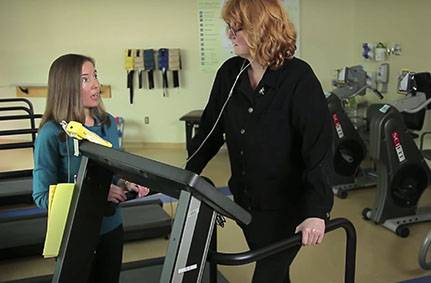Should I exercise?
Exercise is generally recommended for people with chronic lung disease including pulmonary fibrosis. Although exercise training will not improve your lung condition, it does improve cardiovascular conditioning and the ability of your muscles to use oxygen, and may decrease symptoms of shortness of breath. It is helpful in preventing deconditioning and weakness that occurs when people become less active due to shortness of breath.
Is exercise safe?
Moderate exercise that is slowly progressed and does not cause significant symptoms is generally safe. You must make sure you have adequate levels of oxygen during exercise. People with mild, moderate or even severe pulmonary fibrosis can exercise, and exercise training is usually mandatory for people with pulmonary fibrosis waiting for a lung transplant. Exercise can be unsafe if you have undiagnosed or untreated cardiac disease or another major medical condition, and you should always get medical clearance from your doctor before starting an exercise program. Do not start an exercise program on your own if you have ever experienced fainting during exertion or experience chest pain. Exercise may need to be modified if you have significant muscle, joint or circulatory problems.
Do I need medical supervision to exercise?
Although medical supervision is not always necessary, it would be a good idea to talk to your doctor about pulmonary rehabilitation. Pulmonary rehabilitation is a supervised program for people with chronic lung disease that involves exercise training, education and psychosocial support. It is usually done in an outpatient setting, but there are also a few inpatient programs. The goals of these programs are to increase function, improve self-management of your lung condition, decrease symptoms and increase participation in activities of daily living. Programs typically run for 6 to 12 weeks, 2 to 3 times per week. The Canadian Lung Association website has a link to find pulmonary rehabilitation programs in your area: http://www.lung.ca/respDB/search-pulmonary-rehabilitation_e.php.
Other options include community centres or home exercise, although there would not be the same level of supervision or monitoring. You can also consult with a physiotherapist in a clinic.
How do I start to exercise?
During a medical check-up, your doctor may order a walk test or an exercise oximetry test to see if your oxygen levels drop with exertion and if you need home oxygen. If you already use oxygen, your doctor or home oxygen respiratory therapist can tell you how much oxygen you should wear with exercise, as you may require a higher flow rate than what you wear at rest or when sleeping. You may also require a different oxygen delivery system such as high-flow nasal prongs, an oxymizer or oxygen mask with exercise. If you have a current infection, are experiencing deterioration in your condition or have been prescribed major changes in your medications, you may want to hold off starting an exercise program until your condition is stabilized.
What type of exercises should I do?
Consider what types of exercise you enjoy. There are 3 main types of exercises: aerobic exercise, strengthening exercise and flexibility exercise. Aerobic exercise involves continuous exercise using large muscle groups such as walking (outside or on a treadmill), cycling and swimming. Strengthening exercises of the arms and legs can be done using dumbbells, exercise bands, ankle weights, weight machines or using your own body weight such as by climbing stairs or doing squats. Flexibility or stretching exercises of the upper body and muscles around your chest are especially useful. It is recommended to engage in an exercise program that involves all three types of exercise.
How do I monitor my exercise?
Monitoring your response to exercise is very important to ensure a safe program. In pulmonary rehabilitation programs there are 3 responses that are monitored: oxygen saturation, heart rate and symptoms. Some people buy a small portable oximeter to use at home that measures oxygen saturation and heart rate. You should talk to your doctor or physiotherapist about a safe range for oxygen saturation and heart rate with exercise, but in general it is recommended that oxygen saturation remains at least 90% with exercise. Symptoms of shortness of breath and leg fatigue can be measured on the Borg Scale, and it is generally recommended to be within the 3-4 range for exercise.
| 0 | Nothing at all |
| 0.5 | Very, very slight (just noticeable) |
| 1 | Very slight |
| 2 | Slight (light) |
| 3 | Moderate |
| 4 | Somewhat severe |
| 5 | Severe (heavy) |
| 6 | |
| 7 | Very severe |
| 8 | |
| 9 | |
| 10 | Very, very severe |
If you experience any of the following symptoms with exercise stop immediately and follow-up with your doctor:
- dizziness or light-headedness
- chest pain
- visual changes
How much exercise should I do?
You should aim to do aerobic and flexibility exercises 3 to 5 times per week and strengthening exercise 2 to 3 times per week.
Aerobic exercise:
Aim for 20 to 30 minutes of cycling or walking (which can be broken up into 5 or 10 minute intervals with a rest in-between) or up to 10,000 steps during the day which can be measured using a small pedometer or step counter. It is best to build up your time first before increasing your walking or treadmill speed or tension on a bike. Build up your intensity and time of exercise only if your oxygen saturation, heart rate and symptoms are stable. It is recommended to do some warm-up and cool-down exercises such as stepping on the spot, slow walking or stretching exercises before and after aerobic exercise.
Strengthening exercise:
Start with a weight you can lift 10 times and gradually build up the weight as this becomes easy. You can do 1 to 3 sets of 10 repetitions. Make sure you do not strain or hold your breath when lifting weights. If you experience muscle soreness within the next 2 to 3 days following strengthening exercise then decrease the weights you are using.
Are there any other things I should consider?
Cough– many people with pulmonary fibrosis have a persistent dry cough that can make exercise more difficult. Talk to your doctor regarding medications that could decrease your cough. You should stop and rest if you experience a coughing spell during exercise.
Energy conservation– many work and household activities require moderate levels of exertion, so remember to pace yourself and monitor your symptoms the same way as you would with exercise training.
Assistive devices– some people find that a rollator walker helps them to be more active outside the home as it has a seat and a holder for personal items and oxygen tanks.
Air quality– If you are exercising or are active outdoors you may want to check the local air quality health index at http://www.ec.gc.ca/cas-aqhi/default.asp?lang=En&n=450C1129-1 . It is also recommended to avoid exercise in extreme heat or cold.
June 2014
Lisa Wickerson, Physiotherapist Toronto Lung Transplant Program University Health Network
Supported by the Canadian Pulmonary Fibrosis Foundation



